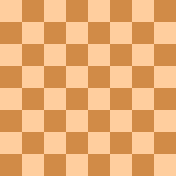Endgame (chess) facts for kids
The endgame in chess is the final part of a game. It happens when there are only a few pieces left on the board. You can also think of the endgame as starting after the middlegame is finished, and the kings are no longer in immediate danger.
Contents
What's Different in the Endgame?
The endgame is very different from the start or middle of a chess game. Here are the main changes:
Pawns Become Super Important
In the endgame, pawns become much more powerful. A big goal is to move a pawn all the way to the other side of the board. This is called promotion. When a pawn reaches the last row, it can turn into a queen, rook, bishop, or knight. This can often help you win the game!
Kings Join the Fight
At the start of a chess game, your king usually hides to stay safe. But in the endgame, the king often becomes a strong attacking piece! You can move your king closer to the center of the board. From there, it can help your own pawns move forward. It can also attack your opponent's pawns and block their king.
Draws Are More Common
Sometimes, a chess game ends in a draw during the endgame. This often happens because there are not enough pieces left on the board for either player to force a win. If neither side can checkmate the other, the game is a draw.
Chess players study endgames to understand which positions can be won and which will likely end in a draw. Knowing this helps them decide whether to keep playing or agree to a draw.
Basic Checkmates
Basic checkmates are special positions where one player has only a king left. The other player has enough pieces to force a checkmate. These are usually the first checkmates new players learn.
Here are some examples of basic checkmates:
- King and queen versus a lone king (K+Q vs K)
- King and rook versus a lone king (K+R vs K)
- King and two bishops versus a lone king (K+2B vs K)
- King, bishop, and knight versus a lone king (K+B&N vs K) – this one can be tricky!
Technical Endgames
| a | b | c | d | e | f | g | h | ||
| 8 |

|
8 | |||||||
| 7 | 7 | ||||||||
| 6 | 6 | ||||||||
| 5 | 5 | ||||||||
| 4 | 4 | ||||||||
| 3 | 3 | ||||||||
| 2 | 2 | ||||||||
| 1 | 1 | ||||||||
| a | b | c | d | e | f | g | h | ||
Technical endgames are positions where the result is known for sure, if both players make the best moves.
Endgame Tablebases
Imagine a giant computer brain that has played every possible chess endgame! That's kind of what an endgame tablebase is. These are huge databases created by computer chess programs. They have analyzed every possible position with a small number of pieces (like six or fewer). The computer figures out the best move for every single one of these positions. This is like proving a math problem by checking every single possible answer.
When people look through these databases to find new information, it's called data mining. These tablebases have shown some amazing things! For example, they've found the longest possible series of moves needed to win a game from certain positions. One amazing discovery was a position where it took 517 moves to reach a win!
Images for kids
See also
 In Spanish: Final (ajedrez) para niños
In Spanish: Final (ajedrez) para niños


